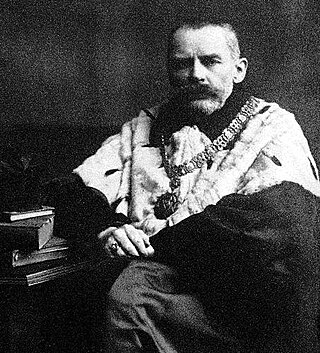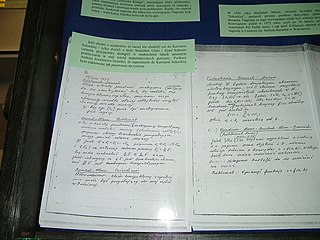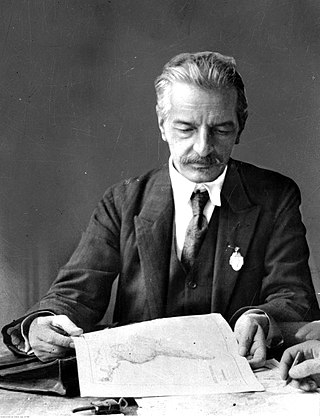
Stefan Banach was a Polish mathematician who is generally considered one of the 20th century's most important and influential mathematicians. He was the founder of modern functional analysis, and an original member of the Lwów School of Mathematics. His major work was the 1932 book, Théorie des opérations linéaires, the first monograph on the general theory of functional analysis.

Wacław Franciszek Sierpiński was a Polish mathematician. He was known for contributions to set theory, number theory, theory of functions, and topology. He published over 700 papers and 50 books.

Kazimierz Kuratowski was a Polish mathematician and logician. He was one of the leading representatives of the Warsaw School of Mathematics. He worked as a professor at the University of Warsaw and at the Mathematical Institute of the Polish Academy of Sciences. Between 1946 and 1953, he served as President of the Polish Mathematical Society.

Hugo Dyonizy Steinhaus was a Polish mathematician and educator. Steinhaus obtained his PhD under David Hilbert at Göttingen University in 1911 and later became a professor at the Jan Kazimierz University in Lwów, where he helped establish what later became known as the Lwów School of Mathematics. He is credited with "discovering" mathematician Stefan Banach, with whom he gave a notable contribution to functional analysis through the Banach–Steinhaus theorem. After World War II Steinhaus played an important part in the establishment of the mathematics department at Wrocław University and in the revival of Polish mathematics from the destruction of the war.

Jan Łukasiewicz was a Polish logician and philosopher who is best known for Polish notation and Łukasiewicz logic. His work centred on philosophical logic, mathematical logic and history of logic. He thought innovatively about traditional propositional logic, the principle of non-contradiction and the law of excluded middle, offering one of the earliest systems of many-valued logic. Contemporary research on Aristotelian logic also builds on innovative works by Łukasiewicz, which applied methods from modern logic to the formalization of Aristotle's syllogistic.

Lviv Polytechnic National University is a public university in Lviv, Ukraine, founded in 1816. According to the Times Higher Education, as of 2024, it ranks first as a technical institution of higher education and second among all institutions of higher education after Sumy State University in Ukraine. Lviv Polytechnic is also the largest educational institution in Ukraine by the number of students and one of the largest by the number of faculties and departments.
Juliusz Paweł Schauder was a Polish mathematician known for his work in functional analysis, partial differential equations and mathematical physics.

Stanisław Mieczysław Mazur was a Polish mathematician and a member of the Polish Academy of Sciences.

The Lwów school of mathematics was a group of Polish mathematicians who worked in the interwar period in Lwów, Poland. The mathematicians often met at the famous Scottish Café to discuss mathematical problems, and published in the journal Studia Mathematica, founded in 1929. The school was renowned for its productivity and its extensive contributions to subjects such as point-set topology, set theory and functional analysis.

Paulin Kazimierz Stefan Żorawski was a Polish mathematician. Żorawski's main interests were invariants of differential forms, integral invariants of Lie groups, differential geometry and fluid mechanics. His work in these disciplines was to prove important in other fields of mathematics and science, such as differential equations, geometry and physics.

Antoni Marian Łomnicki was a Polish mathematician. He contributed to applied mathematics and cartography. He was the author of several textbooks of mathematics and was an influential mathematics teacher at the University of Lwów.

The Polish Mathematical Society is the main professional society of Polish mathematicians and represents Polish mathematics within the European Mathematical Society (EMS) and the International Mathematical Union (IMU).

The Ivan Franko National University of Lviv is a public university in Lviv, Ukraine.

The Scottish Book was a thick notebook used by mathematicians of the Lwów School of Mathematics in Poland for jotting down problems meant to be solved. The notebook was named after the "Scottish Café" where it was kept.

Eugeniusz Mikołaj Romer was a distinguished Polish geographer, cartographer and geopolitician, whose maps and atlases are still highly valued by experts.

Janusz Witwicki was a Polish architect and art historian, creator of the Plastic Panorama of Old Lviv.

A louse-feeder was a job in interwar and Nazi-occupied Poland, at the Lviv Institute for Study of Typhus and Virology and the associated Institute in Kraków, Poland. Louse-feeders were human sources of blood for lice infected with typhus, which were then used to research possible vaccines against the disease.

Zbigniew Ciesielski was a Polish mathematician specializing in functional analysis and probability theory. He served as the President of the Polish Mathematical Society from 1981 to 1983.

The Institute of Mathematics of the Polish Academy of Sciences is a research institute of the Polish Academy of Sciences (PAN) headquartered in Warsaw at 8 Śniadeckich Street.

Eustachy Karol Żyliński was a Polish mathematician and university professor known for his work on number theory, algebra, and logic. He was a member of the Lwów School of Mathematics.



















